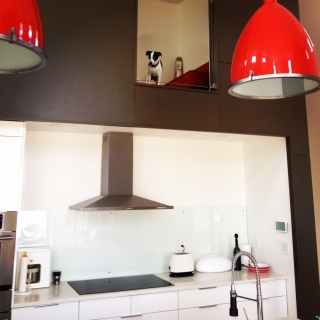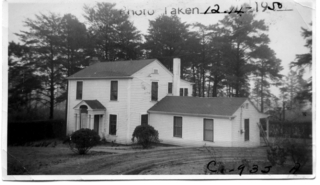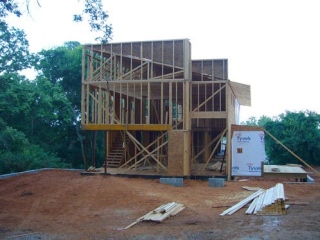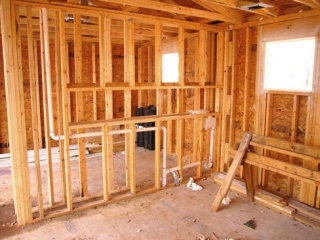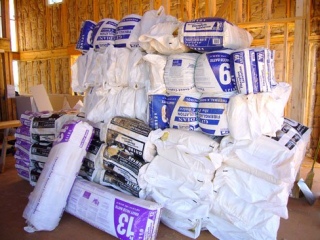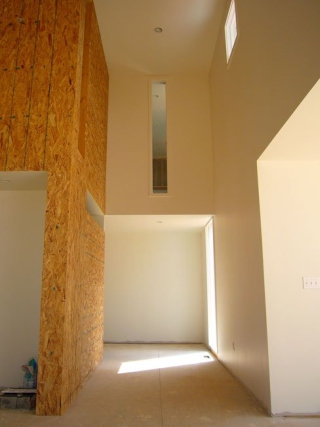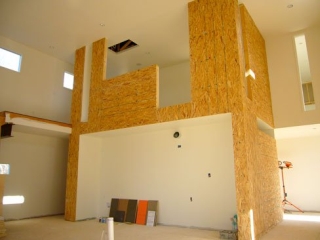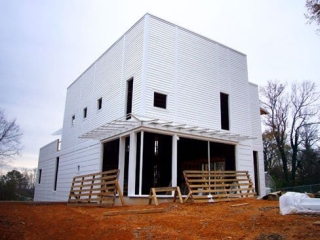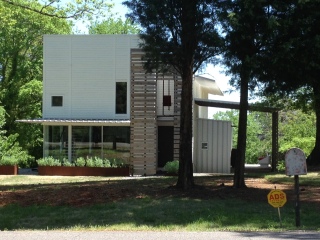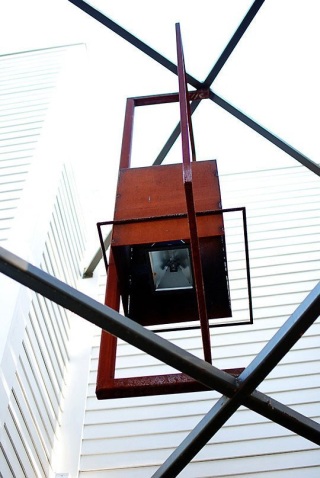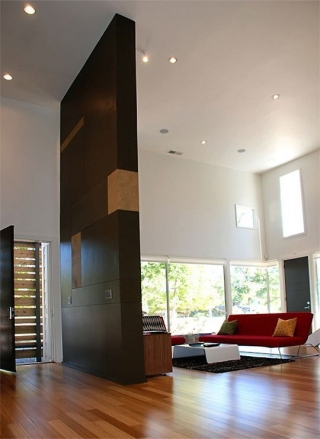Liane and Roy initially found their
lot in October 2007 but it was outside their budget. Five months
on the market, and a slowing economy resulted in a significant price
cut. The land was then within their budget so the Burns made the
move to purchase the property in March 2008.
The house that was originally on the
property had been torn down years before. Someone had bought the
house with the intention of remodeling but quickly realized they
were in over their head and what was left had to be taken down. As
the lot sat vacant for many years, it became very overgrown and
quite scary looking, as the Burns called it. "We really had
rose-colored glasses!”, Liane says.
Matthew Finley and Will Brothers of
Green Bottle Workshop designed and built the Burns home. Both
graduates of Auburn University's Rural Studio program really caught
the attention of the Burns as a possibility for their future home.
"They were agreeable to our design and budget.” Finley and Brothers
were not only schooled in creating innovative and
internationally-acclaimed design, but also in getting the most out
of humble materials (i.e. off-the-shelf vs. custom, recycled,
reclaimed and repurposed materials) as a way of stretching budgets
without sacrificing design aspirations. “Our house was the first
residential project that they designed and built from the ground
up,” Liane says.
From the beginning,
the Burns were interested in being as green as possible with their
design plans. As with any build, the budget often limits or takes a
hit to the overall plan. “Unfortunately, we soon discovered that
most of what we were aiming to do would put us considerably over
budget,” she says. Green Bottle’s plan to achieve the vision the
Burns had was to design a home in such a way that it would maximize
energy efficiency but keep the family on budget. The window
placement was the biggest part of the plan. “With all the natural
light, our electricity use for lighting is kept to a minimum,” Liane
says. Including the design process the home took 14 months to
build.
The front and entry
way to the home has contrasting materials, wood and weathered steel
compliment the white fiber-cement board siding. The pendant light
that stands as a statement of its own is a bespoke steel pendant
designed by Will and Matthew. At night the light from the pendant
fills the outer elements of the home and the entire structure glows
with warm light like a lantern or lighthouse on the crest.
House Note: The
Burns chose the Hardie Board siding because it is a
low-maintenance product. It’s
termite-proof, fire-resistant, and doesn’t
rot!
The interior of
the home is mostly white. The Burns chose Benjamin Moore paint
in dove white. Countertops in the kitchen and guest bathroom
were the only splurges. The Burns were able to get their top
choice, Silestone® Quartz by Cosentino. Silestone has built-in
Microban® an antimicrobial protection element and is certified
by National Sanitation Foundation and holds
Greenguard Indoor Air Quality certification.
Silestone Quartz countertops are non-porous, which inhibits the
growth of bacteria, mold and mildew. The countertops are a
perfect fit for an eco-friendly home.
The floating
staircase to the upstairs have steel supports and bamboo
treads. The open design allows light from the living area to
stretch through to the hallway. The openness aids in the
illusion that the individual steps are floating.
House Note: The beautiful floors are
bamboo.
Bamboo is a renewable resource- Where oak takes 120 years to grow to
maturity, bamboo can be harvested in three years and is recognized
as a green material under LEED.
Behind the walls It’s
CPVC! Unlike metal, CPVC plumbing systems are more environmentally
friendly and resist corrosion. The pipes themselves are also much
easier to handle and install than metal, comply with most building
code standards, and are budget friendly. For insulation, the Burns
first wanted to go with Bonded-Logic’s
UltraTouch Recycled Cotton Insulation. Ultratouch is made from 85%
post-consumer recycled denim and is treated with borate to resist
fire, mold/mildew, and insects. That’s right, your Calvins could be
in somebody's wall.
Unfortunately, the
Ultratouch was found to be outside of budget.
Green Bottle
Workshop was
able to find something in the Burns price range that was still
respectful to their desire to stay clean and green in Guardian
Building Products. According to the Guardian site: “Guardian
Fiberglass meets the highest possible product certification for
indoor air quality standards—Greenguard
Certification.”
The outdoor deck is
composite over wood.
Composite is blended ground-up wood and plastic and can last two to
three times longer than regular traditional decking materials.
Unlike wooden decks, composite does not have to be regularly painted
or stained.
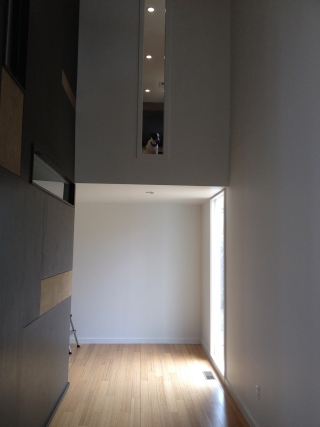 |
|
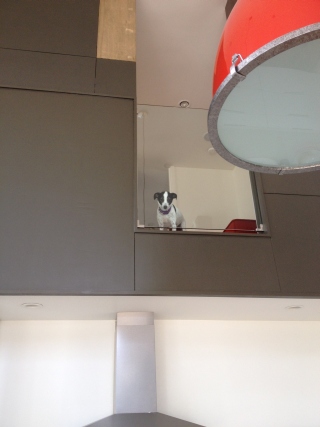 |
House Note: The home has a metal roof for similar reasons to the
siding - it's supposed to last 50 years!
The Burns have now
lived in Bluff Park for five years in their peaceful home. "We
love it," Liane says. "It's like living in a work of art. It's
clean and minimal, yet comfortable and homey. We love our
neighborhood and neighbors. It's been a joy living in this
great white box," she says.
A busy life has
made it challenging to be able to continue improvements and
implement extra phase things like an
outdoor
fireplace
as
quickly as
the Burns would like. Ultimately, they will
pursue solar
and the roof design would be amenable to that. "Our future plans
for adding to the home's greenness are to add a tankless water
heater and rain barrel water collection system for landscaping
maintenance," Liane says.
Zee
savors the views from
her unique
Bluff Park home. "She seems to love being here. She is able to
keep an eye on everything here while enjoying the sun as it
fills the house," Liane says. From all the floor length windows
throughout the house, Zee has quite the view!
Sources
www.BluffParkAl.org interview with Liane Burns
Green Bottle
Workshop now, Built In Alabama
http://www.biltinalabama.com


